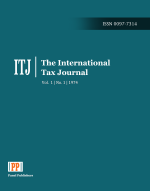Legal protection of the child of unknown parentage: Between Algerian legislation and international conventions
Keywords:
protection, child, unknown, Algerian legislation, international conventionsAbstract
There is no doubt that among the important topics that impose themselves in the area of law is the question of protection the child of unknown parentage, which has received varying degrees of attention and care in national legislations and international conventions. This necessitates research and shedding light on the issue of legal protection concerning this child, whether in Algerian legislation or in international conventions.
Downloads
References
1. Abd El-Gawad, M. (1991). Maternal and child protection in international conventions and Islamic law (1 ed.). Maktabat al-Ma'arif, Alexandria, Egypt.
2. Abdelaziz, S. (1996). Marriage and divorce in Algerian family law (3 ed.). Algeria: Houma Publishing and Distribution.
3. Algeria, S. C. (1991, 4 23). Decision regarding the recognition of paternity under French law conflicting with Algerian public order due to non-conformity with Islamic law.
4. Algerian Parliament. (2005). Algerian Parliament. (2005, June 20). Ordinance No. 75-58 of September 26, 1975, on the Civil Code, amended and supplemented by Law No. 05-10 of June 20, 2005.
5. Algerian Penal Code. (1966). Article 315. Official Gazette of the People's Democratic Republic of Algeria, No. 49, June 11, 1966.
6. Algerian penal code, A. (1966). Art. 314, Ordinance No. 66-156 of June 8, 1966, Official Journal of the Algerian Republic, No. 49, June 11, 1966. one of their organs, the punishment shall be imprisonment from five to ten years. If the abandonment or exposure leads to death, the punishment shall be imprisonment from ten to twenty years.". "Anyone who abandons a child or a disabled person unable to protect themselves due to physical or mental condition, or exposes them to danger in an uninhabited place, or causes someone else to do so, shall be punished for this act alone with imprisonment: from one to three years. If such abandonment or exposure results in illness or total disability lasting more than twenty days, the imprisonment shall be from two to five years. If the child or disabled person suffers amputation or permanent disability in.
7. Belhaj, A. (n.d.). The concise explanation of Algerian family law. Ben Aknoun, Algeria: Diwan of University Publications.
8. Ben Malha, G. (2004). Family law in light of jurisprudence and case law (1 ed.). Ben Aknoun – Algeria: University Publications Office,.
9. Ben Othman, N. I. (2009). The best interest of the child in Algerian family law. Tlemcen: Abou Bekr Belkaid University, Faculty of Law.
10. Bouskiaa, A. (2003). The essentials of special criminal law: Crimes against persons and crimes against property. Bouzareah – Algeria: Dar Houma.
11. Chazal, J. (1983). Children’s rights (1 ed.). Beirut–Paris: Awidat Publications.
12. Djami, L. (n.d.). Child protection: A comparative study between Algerian law and Islamic Sharia.
13. Djemai, L. (n.d.). Child protection: A comparative study between Algerian law and Islamic Sharia. Doctoral dissertation. University of Oran, Faculty of Law.
14. Fekhar, H. B. (2014-2015). Criminal Protection of the Child in Algerian Legislation and Comparative Law. Doctoral thesis. Mohamed Khider University of Biskra.
15. Frija, H. (2006). Explanation of the Algerian Penal Code. University Publications Office.
16. Gazette Official. (1996). People’s Democratic Republic of Algeria Constitution of Algeria (Article 132).
17. Gazette, O. (1966). Order No. 66/156 dated June 8, 1966, which includes the Penal Code, as amended and supplemented.
18. Gazette, O. (1996). People’s Democratic Republic of Algeria. (1996). Constitution of Algeria (Article 132). Official Gazette.
19. Government of Algeria. (1989). Interpretative declarations on the Convention on the Rights of the Child .
20. Government, A. (1970). Ordinance No. 70-20 of February 19, 1970, concerning the Civil Status Law. Official Gazette of the People's Democratic Republic of Algeria, No. 21.
21. Hadi, A. A. (1994). The Convention on the Rights of the Child: A Step Forward or a Step Back? Journal of Law, 17(3).
22. Hadj Ali, B. D. (2009-2010). Criminal protection of children in Algerian law. Master's thesis. Faculty of Law and Political Science, Abou Bakr Belkaid University, Tlemcen.
23. Houhou, R. (n.d.). The International Criminal Protection of Human Rights. Al-Mufakkir Journal(5).
24. Jomaa, L. (n.d.). Child protection: A comparative study between Algerian law and Islamic law.
25. Law No. 84-11. (1984). of June 9, 1984,on the Family Code, amended and supplemented by Ordinance No. 05-02 of February 27, 2005.
26. Ministry of Health. (2023). Annual reproductive health statistics report. Government of Algeria. Retrieved from https://www.sante.gov.dz/statistics2023
27. NationsUnited. (1989). Article 2, Paragraph 1 of the United Nations Convention on the Rights of the Child (1989):. "The States Parties shall respect and ensure the rights set forth in the present Convention to each child within their jurisdiction without discrimination of any kind, irrespective of the child's or his or her parents' or legal guardians' race, color, sex.
28. Saad, A. A. (1990). Crimes against the family system. National Book Institution.
29. Saad, F. (n.d.). Explanation of Algerian Family Law.
30. Saeed, H. M. (n.d.). The protection of children's rights in international public law and Islamic law.
31. Taha, M. A. (1999). Criminal protection of the child victim (1 ed.). Naif Arab University for Security Sciences.
32. Theniou, A. (2006). Children’s rights in Sharia and law: A comparative study between Islamic Sharia and the 1989 United Nations Convention on the Rights of the Child. Master’s thesis, Emir Abdelkader University of Islamic Sciences, Constantine.
33. United Nations. (1966). International Covenant on Civil and Political Rights Article 24(2).
34. United Nations. (1995). Beijing Declaration and Platform for Action. Fourth World Conference on Women, Beijing, China.
Downloads
Published
How to Cite
Issue
Section
License
Copyright (c) 2025 The International tax journal

This work is licensed under a Creative Commons Attribution-NonCommercial-NoDerivatives 4.0 International License.








